Mountains Behind Haiti’s Protests
Haitian proverb:
“Dèyè mòn, genyen mòn.”
(Behind mountains hide more mountains.)
Haiti’s most populous cities erupted in marches, sit-ins, strikes, and barricades throughout September 2012. This revolt began with the teachers during the first week of the month. By Monday, September 10, the country’s educators were protesting, not only in Port-au-Prince, but also in Jeremie, Saint-Marc, and other towns for better work conditions, work contracts, and a minimum salary of 50,000 gourdes ($1,162) per month. They have been joined by virtually all sectors of the population. Some areas of the country remain more or less in a state of continuous protest against human-rights abuses, soaring food prices, 80 percent unemployment, crashing agriculture, government corruption and racism, and many other ills.
Capital city of Port-au-Prince
Tuesday, September 11 march
Protesters with plates, spoons and forks marched to Port-au-Prince’s Bicentennaire Plaza, where they clanged about their hunger to the Prime Minister and charged him with incompetence.
In this capital city where the majority of the earthquake’s homeless live and more are displaced daily from their homes for what they say are government-sanctioned land grabs, the protesters denounced programs like “Aba grangou” (down with hunger), “Ti manman cheri” (darling little mother), and “Katye pam poze” (my neighborhood is peaceful) as having done nothing much.
One interviewed protester said:
“You can’t ask someone to sweep the streets, give him a pittance every month and think you’re going to help him live better.”
A 40 percent hike in food prices since May has been blamed on everything except the government’s policy of neglecting local agriculture while allowing the market to be flooded with subsidized agricultural goods from the United States. For a while, Tropical Storm Isaac was a convenient villain. On Monday Trade Minister Wilson Laleau brought up the overseas summer droughts. His greatest concern, however, was not the looming famine but the possibility of food riots, as happened in 2008.
Terminated state employees marched the next day to demand better living conditions and 36 months of back pay.
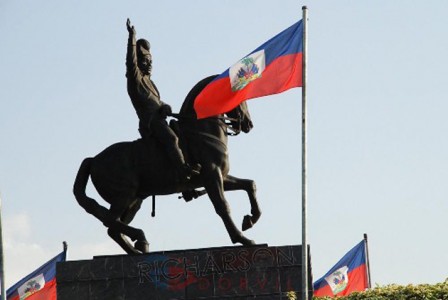
Sculpture of Haitian Independence hero General Jean-Jacques Dessalines, born September 20, 1758 (Photo: HPN).
On Thursday September 20, the anniversary of Dessalines’ birthday, there was no march in Port-au-Prince, despite one being scheduled. Is one to believe that protests were held in Haiti nearly every day in September except on the birthday of Independence Hero Jean-Jacques Dessalines? Here is how it was done. The Haitian government arrested a few journalists, and the rest focused on their colleagues, leaving the protest uncovered. A similar tactic of arresting journalists was used to deflect reports of massive protests on Haiti’s Flag Day, May 18.
Some results of the activism
Government Chief Prosecutor Jean Renel Senatus was dismissed from his post without explanation on Thursday September 27. Mr. Senatus was better known as “Komisè zokiki” (commissioner of teen night-clubbing) because he seemed more interested in thwarting night-clubbing teens than in serious crime.
Sunday September 30 Lavalas march
An estimated 10,000 to 30,000 people responded to Lavalas’ call to protest against the Martelly regime on the anniversary of the first bloody coup against Aristide, which killed about 3,000 to 5,000 Lavalas partisans seven months after he took office. Protesters marched from the La Saline neighborhood to Saint Jean Bosco, circling the city.
Among the protesters’ slogans:
Pèp la paka manje, n’ap voye’w ale!
(The people cannot eat, we’re kicking you out!)
“Aba MINUSTAH! Aba UN! Aba Michel Mateli! Aba Loran Lamot! Aba Sofya Mateli! Nou pa vle moun kle sou pouvwa ou peyi 95 pousan moun nwa!
(Down with MINUSTAH! Down with UN! Down with Michel Martelly! Down with Laurent Lamothe! Down with Sophia Martelly! We don’t want mulattoes ruling a 95 percent black country!)
“Di Obama, di Obama kenbe kakal la!”
(Tell Obama, tell Obama to keep his shit!)
Several lawmakers accompanied the protesters, including MP Arnel Belizaire, Senator Moise Jean-Charles (North), Senator Francky Exius (South), former Senators Louis Gerald Gilles and Turneb Delpe, and former Senator, Minister of Justice and INITE Party leader Paul Denis.
Video of Lavalas protest on Sunday, September 30, 2012 (Courtesy: frantzetienne1).
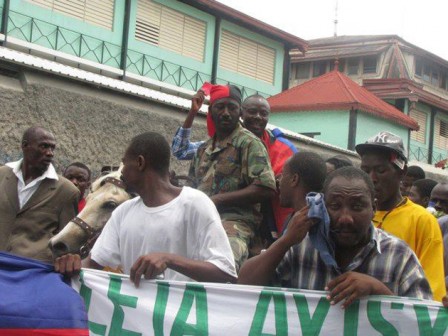
Senator Moise Jean-Charles, on horseback in the flag’s blue and red, is greeted by the crowd at Lavalas protest on Sunday, September 30, 2012 (Photo: Tout Haiti).
Second largest city, Cap Haitien
Wednesday, September 12 march
Thousands of protesters, including the region’s Senator Moises Jean-Charles and over 20 popular organizations, marched to call for Martelly’s resignation and accuse him of cronyism.
The population was especially angry about Martelly’s appointment of Gaby Silencieux as Deputy Commissioner for the Limbe District in the Northern Department. Mr. Silencieux is wanted by police for murder and arson.
Martelly and his North Department Delegate Yvon Alteon were also accused of collusion with a land-grabbing family in the Petit Anse area that claims to be related to 19th-century Haitian President Jean-Pierre Boyer and to own the titles to one third of the city. The family has threatened to evict thousands from the neighborhoods of Lafossette, Chada I and II.
Land prices in the north have skyrocketed because of the anticipated arrival of foreign mining personnel. A tactic of withholding city services, such as electricity and running water, is being used throughout Haiti to discourage people from living in some areas. For example, the cities of Cap Haitien and Gonaives have had no municipal water for months due to sabotage. In addition sugar-cane and rum production, an important industry in Cap Haitien that employed thousands, has been under attack since two years from a systematic dumping of imported ethanol. More than 12 distilleries have shut down.
A sit-in on the Cathedral Square followed the next day to protest against the general deterioration of living conditions and the hunger brought on by the hike in food prices. This event was organized by l’Organisation du Peuple en Lutte (Organization of Peoples for Struggle, OPL) political party, headed by Eluscar Charles. Protesters conducted a symbolic trial of members of the government and demanded that Martelly and his team show what they have done.
Simultaneously in nearby Leogane, protesters blocked National Highway No. 2, charged the Martelly-appointed municipal council with incompetence and called for transparency in the public works on the Rouyonne River.
Friday, September 21 march
On the eve of this new protest in the “City of Christophe” the tense atmosphere led most residents to stay off the streets after dark. In the Chada neighborhood, rounds of gunshots resonated. Three individuals were injured, two by bullet wounds. Angry residents threw rocks and bottles at the police (PNH) injuring one policeman.
On the morning of the protest, commercial banks closed early, and transportation slowed to a crawl as many thousands took to the streets.
Among the protesters were:
- Former member of Parliament Eddy “Briguel” Jean Pierre,
- Former Mayor Fritz Joseph,
- Initiative Citoyenne party representative Gary Denis,
- Organisation du Peuple en Lutte party northern representative Elusca Charles together with former candidates Carly Eugene et Pierrot Augustin,
- Lavalas activist Remy Saint-Juste.
Marchers brandished red cards and shouted:
“Aba Mateli ak koripsyon!”
(Down with Martelly and corruption!)
“Aba grangou roz!”
(Down with pink hunger!)
This is reference to Martelly and his men, who wear pink, and his election promise of a rosy life.
“Resous peyi a se pou tout Ayisyen!”
(The country’s resources are for all Haitians!)
These and other slogans expressed a deep anger about the incompetence and cronyism of the central government, soaring food prices, land grabs, and general disregard for human rights.
Some results
Ardoin Zephirin was named the new North Department Delegate on Monday September 24; he replaced Yvon Alteon, who was in the U.S. for his health and had been accused of complicity in an attempted land grab in Petit Anse. Antonio Jules was named the new Vice-Delegate for Cap-Haitien.
Thursday, September 27 march
Despite an invasion of Cap Haitien by Martelly’s pink army of paramilitaries, and a siege of the more activist neighborhoods, thousands more took to the streets to call for an end to the Martelly-Lamothe administration.
When the protesters tried to conclude their march in Vertieres — site of the final battle for Independence — the police made four arrests. Together with six people arrested last week and still not released, this brought to 10 the number of Cap Haitien protesters incarcerated.
Many of the regions’ prominent politicians, including Senator Moise Jean-Charles and former MP Hugue Celestin, took part in the protests. Sen. Jean-Charles, an organizer, warned that democracy is under threat. He said:
“We are no longer marching about the high cost of living…. Now we want the president to go.”
Sen. Jean-Charles had announced a general strike in Cap Haitien for Monday October 1, 2012 to call for Martelly’s resignation; however the strike was cancelled at the last minute due to threats of violence from Martelly’s people.
Third largest city, Les Cayes
Thursday, September 13 general strike
Throughout the city, tracts were circulated that read:
“Ensekirite Aba! Aba lavi chè! Aba koripsyon medyokrite ak-nan gouvènman Mately ak Lamot!”
(Down with insecurity! Down with price hikes! Down with the corruption and mediocrity of the Martelly-Lamothe government!)
in anticipation of a strike to protest rising food prices, arbitrary changes to the city’s judiciary by the central government, and increasing acts of banditry that are tolerated or instigated by police. Last June, for example, the city’s main radio station Radio Monopole was burned to the ground in an act of arson.
According to organizers and monitors in place, over 75 to 90 percent of the population observed the general strike. Until early afternoon, formal and informal trade were paralyzed. Gas stations, commercial banks, stores, and public markets were closed, leaving the streets empty.
During a midday conference, organizer Gabriel Fortune said:
“Apart from the transport sector, which operated at 60 percent, all other sectors, including private business have kept their word.”
Mr. Fortune is a former senator and departmental delegate who previously supported Martelly but became one of his major opponents.
After a debate on Radio-Télé Caramel’ s “Face-to-Face” television program between Mr. Fortune and Secretary of State for Communication Joseph Guyler C. Delva, the latter required a police escort to leave the station as a hostile crowd hurled anti-government insults at him like “defender of the devil.”
As in Port-au-Prince, the protesters in Aux Cayes denounced programs like “Ti manman cheri” (darling little mother) and said they had not been implemented. According to the organizers, this protest was merely “a warning shot,” and more actions will follow if nothing gets accomplished.
Some results
The government failed in its attempt to transfer First Circuit Court Dean Pierre Vaval Ezekiel and Government Commissioner Jean-Marie Solomon away from Les Cayes, and both were returned to their respective posts on Wednesday, September 19, 2012. They thanked the people for having mobilized to enforce the law and called on their colleagues to do their work fairly to maintain the citizenry’s support. Madame Jean-Julien who had arrived from Anse-à-Veau to replace Peter Ezekiel Vaval, quietly left town.
Wednesday-Friday, September 19-21 protests
Cayes’ teachers and their unions took to the streets on Wednesday to demand better work conditions, several years of back pay, plus a minimum monthly salary of 50,000 gourdes ($1,162). Protesters included Movement by Educators to Renew Haiti’s Education System coordinator Jean Jose Delva, and national teachers’ union speakers Josue Merilien (UNNOH) and Prof. Iverlt Jean-Louis (UNEH).
On Thursday evening and Friday morning, the city spontaneously erupted in protest against a call by the central government for the removal of Departmental Delegate Etienne France and the appointment of a new Departmental Delegate for the South. Tires burned on the streets.
In nearby Miragoane (also in the south), hundreds took to the streets on Friday, to protest against unemployment and the rising cost of living and call for an end to the Martelly-Lamothe regime.
What is being done?
Prime Minister Laurent Lamothe excused himself from a Friday, September 14 meeting with the Chamber of Deputies, that would have addressed the issues raised in the protest, because he was too busy. Instead he announced the formation of a Commission for Price Stabilization and the acceptance of a Japanese gift of 288,000 30-kg sacs of rice. This amounts to about 9,500 tons, or about a week’s consumption (seven times Haiti daily consumption of about 1,300 tons); moreover, the arrangements for donation of the rice date back to March of this year.
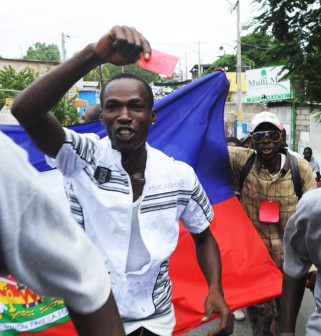
Protester brandishes a red card and shouts “Voyé’l alé! Rouj!” – Kick him out! Red! [card] to the Martelly-Lamothe regime (Photo: Radio Kiskeya).
Legislators once again invited PM Laurent Lamothe to a meeting, this time for Friday September 21, 2012. Instead, that afternoon, on Scoop FM, Mr. Lamothe qualified the day’s protests in several cities as the actions of “political agitators” and “mercenaries.” He elaborated that “A mercenary is someone who receives money to create problems and to destabilize.”
The most serious response to the popular protests was the announcement by Haiti’s Social Affairs Minister of a minimum wage increase, effective October 1, 2012 for assembly work to $0.87 per hour: a scandalously low minimum wage that is strongly opposed by Haiti’s garment sector.
Editor’s Notes: Featured photograph of Lavalas protest on Sunday, September 30, 2012 by Etant Dupain.
Dady Chery is a journalist, playwright, essayist and poet, who writes in English, French and her native Creole. She is the Editor of Haiti Chery.
Related Articles


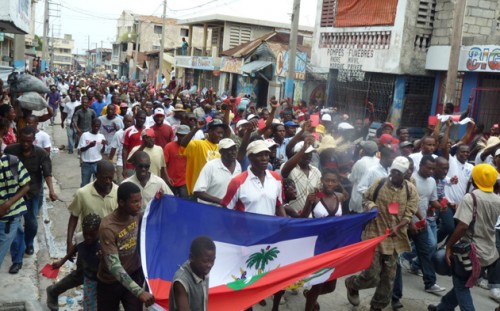
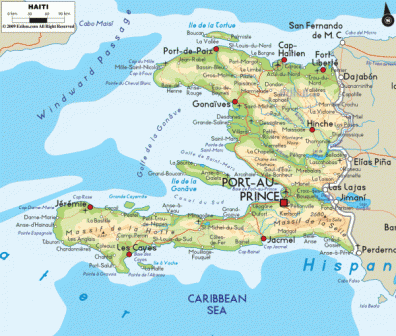
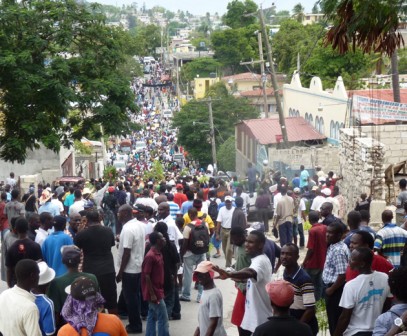
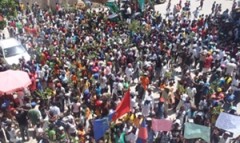
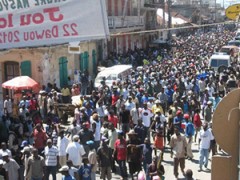
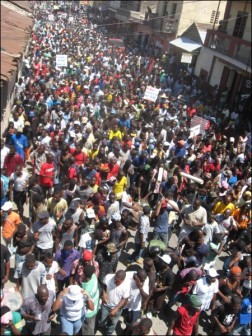
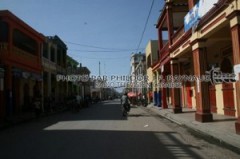











2 Responses to Mountains Behind Haiti’s Protests
You must be logged in to post a comment Login